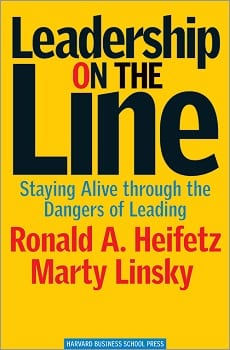You may not have thought of your role as pastoral leader as a particularly dangerous one, but two writers in the field suggest you reconsider. Ronald A. Heiftez and Marty Linsky are faculty members of Harvard University’s John F. Kennedy School of Government and principals of Cambridge Leadership Associates. Together they share more than fifty years of teaching, research, and consulting.
In Leadership on the Line Heiftez and Linsky suggest that leadership opportunities of all sorts, from that of a CEO to that of a parent or neighbor, are risk-taking ventures. Leadership requires that we challenge things people hold dear – not just their ideas, but their practices, habits, and ways of life. Consequently, efforts at leadership can be met with varying degrees of push-back and even sabotage. But, they argue, such efforts to make a difference are worth the risks and that the risks can be managed successfully with some key practices.
The book is divided into three parts. In Part One the authors describe the ways in which leadership is inherently dangerous and how it is that people who attempt to lead may find themselves pushed aside.
Part Two offers five practices designed to lower the risk of being seduced, marginalized, or diverted from the hard work of leadership. Chapter three calls for developing a higher degree of objectivity, “getting on the balcony,” to gain a better perspective on the big picture. Heiftez and Linksky call for leaders to learn to “think politically” in chapter four. This requires developing and nurturing relationships, whether they are with people who side with you on the issue, stand in opposition to you, or are uncommitted. In the fifth chapter they call for leaders to “orchestrate the conflict” by creating a holding environment, a safe place for people to think and discuss difficult issues. Leaders also “control the temperature” of the discussion, “set the pace” for its progress, and “show people the future” they are moving toward. In chapter six they encourage leaders to “give the work back,” letting others take responsibility for solutions to their problems. The leader plays a more catalytic role of intervening with questions or observations. Finally, the writers call for leaders to “hold steady” as the efforts at change progress. This means learning to “take the heat,” receiving people’s angers without caving to their demands. It also means keeping attention focused on the issue rather than allowing things to be diverted.
In the third part of the book, “Body and Soul,” leaders are called to take responsibility for themselves, managing their personal vulnerabilities, engaging self-care, and keeping their spirit sustained through the perilous tasks of leading.
Although not written specifically for congregational leaders, much that these writers offer translates easily to the roles of pastoral leadership. The book is filled with stories and examples, making the principles concrete for the reader. Leaders who understand that leadership is not a bag of tricks or techniques to manipulate people will find here ideas for formulating a way forward during “dangerous times” and may also find the encouragement to take the risks and make a difference.
Recommended by Dr. R. Robert Creech, Professor of Christian Ministries and Director of Pastoral Ministries at Truett Seminary
